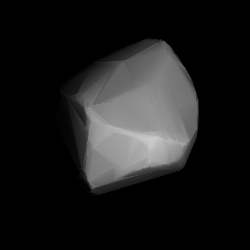Related Research Articles

Coelestina is a typical Main belt asteroid.
Haidea is a large asteroid residing in the asteroid belt. It was discovered by Auguste Charlois on 19 May 1893 in Nice.

Hippo is a rather large main-belt asteroid. It was discovered by Auguste Charlois on August 25, 1897, in Nice. In the 22nd century, it will come closer than 6,000,000 km (0.04 AU) to the larger asteroids 65 Cybele and 511 Davida.

Galene is a typical main belt asteroid. It was discovered by the French astronomer Auguste Charlois on 27 August 1897 from Nice, and was named after Galene, one of the Nereids of Greek Mythology. This asteroid is orbiting the Sun at a distance of 2.97 AU with a period of 5.12 yr and an eccentricity of 0.12. A computer search suggests it is the most likely parent body of the impactor that generated the temporary cometary activity of 7968 Elst–Pizarro in 1996.
Monachia is an asteroid orbiting within the Flora family in the Main Belt.
Lotis is a large Main belt asteroid. It is classified as a probable C-type asteroid and is likely composed of primitive carbonaceous materials. This object was discovered by Auguste Charlois on 23 November 1897 in Nice.
Nephele is a large Themistian asteroid. It is spectral C-type and is probably composed of carbonaceous material.
Pythia is a typical Main belt asteroid.
Rhodia is a Main belt asteroid that was discovered by French astronomer Auguste Charlois on 16 July 1898 in Nice. It was named after one of the Oceanid nymphs of Greek mythology. This asteroid is orbiting the Sun at a distance of 2.39 AU with a period of 3.69 years and an eccentricity (ovalness) of 0.25. The orbital plane is tilted at an angle of 7.3° to the plane of the ecliptic. 437 Rhodia was originally a proposed fly-by target of interest for the Rosetta mission.
Urhixidur is a relatively large main belt asteroid. It was discovered on 18 January 1903, by astronomer Max Wolf (1863–1932), at the Heidelberg Observatory in southwest Germany. Like 500 Selinur and 502 Sigune, it is named after a character in Friedrich Theodor Vischer's then-bestseller satirical novel Auch Einer.

Nassovia is a minor planet orbiting the Sun. It is a member of the Koronis family of asteroids.

621 Werdandi is a Themistian asteroid.
625 Xenia is a minor planet orbiting the Sun. It was discovered in 1907 by August Kopff. The name may have been inspired by the asteroid's provisional designation 1907 XN.
668 Dora is an asteroid orbiting in the asteroid belt located roughly between the orbits of the planets Mars and Jupiter. The name may have been inspired by the asteroid's provisional designation 1908 DO.
963 Iduberga is an S-type asteroid from the asteroid belt's background population. Its rotation period is 3.02 hours.
966 Muschi is a main belt asteroid. It was discovered on 9 November 1921 by the German astronomer Walter Baade out of the Hamburger Sternwarte. Baade named the asteroid after his wife's nickname.
1818 Brahms, provisional designation 1939 PE, is an asteroid from the inner regions of the asteroid belt, approximately 6 kilometers in diameter. It was discovered on 15 August 1939, by German astronomer Karl Reinmuth at Heidelberg Observatory in southern Germany. The asteroid was named after composer Johannes Brahms.
6144 Kondojiro (1994 EQ3) is an asteroid discovered on March 14, 1994 by Kin Endate and Kazuro Watanabe at the Kitami Observatory in eastern Hokkaidō, Japan. It is named after Jiro Kondo, a Japanese Egyptologist and professor of archaeology at Waseda University.

341520 Mors–Somnus, provisional designation 2007 TY430, is a binary and plutino. It consists of two components less than 60 kilometers in diameter, orbiting at a distance of 21000 km.
2021 DR15 is a large trans-Neptunian object in the scattered disc, around 700 kilometres (430 miles) in diameter. It was discovered on 17 February 2021, by American astronomers Scott Sheppard, David Tholen, and Chad Trujillo using the 8.2-meter Subaru Telescope of the Mauna Kea Observatories in Hawaii, and announced on 17 December 2021. It was 89.4 astronomical units from the Sun when it was discovered, making it one of the most distant known Solar System objects from the Sun as of December 2021. It has been identified in several precovery images as far back as 10 March 2005.
References
- ↑ "430 Hybris (1897 DM)". JPL Small-Body Database . NASA/Jet Propulsion Laboratory . Retrieved 10 May 2016.